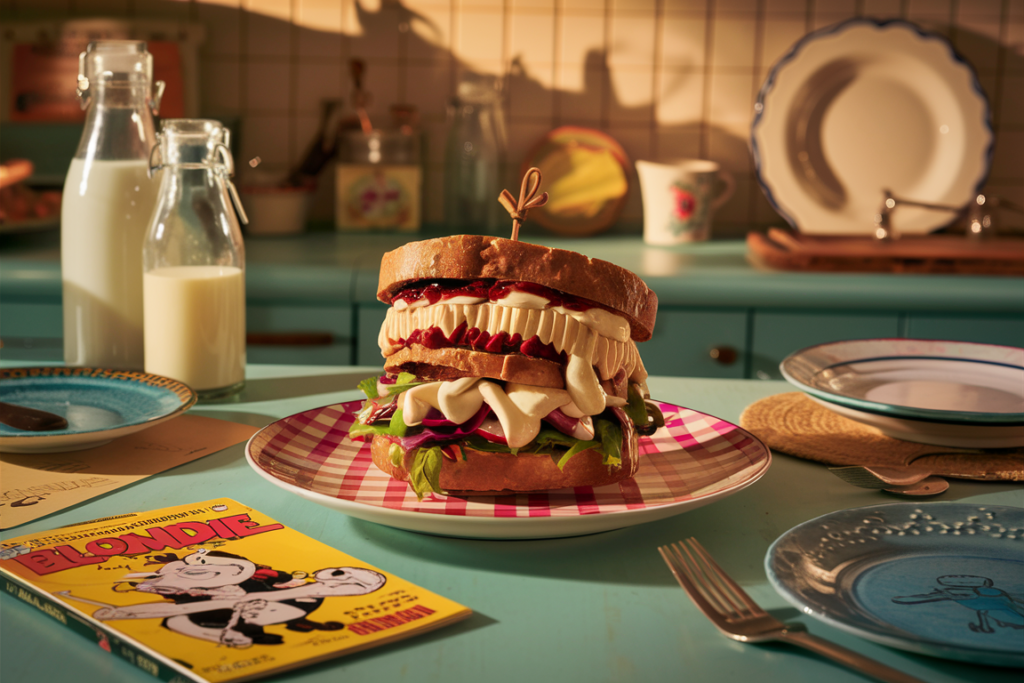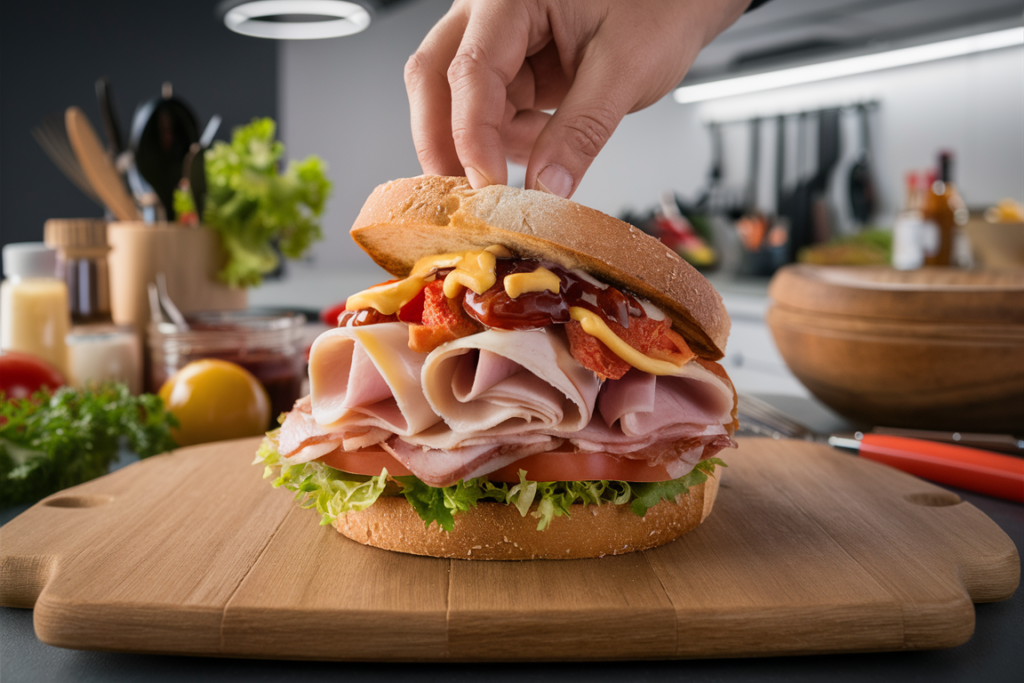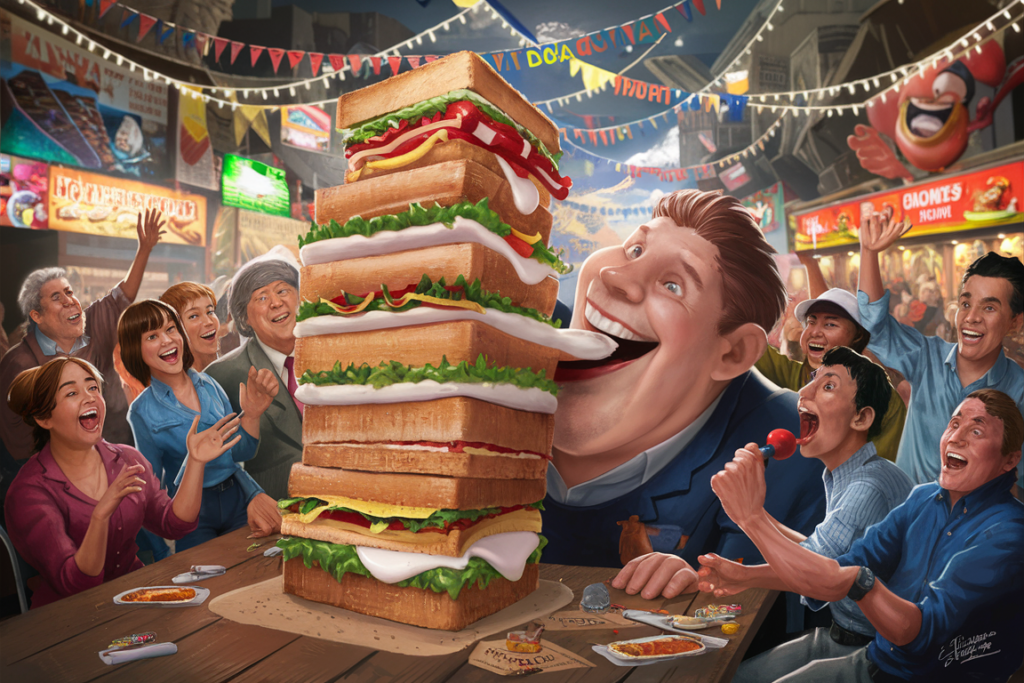Part 1: Introduction and History
The Dagwood sandwich has captured the imagination of food lovers for decades. Known for its towering layers of meat, cheese, vegetables, and bread, the Dagwood is more than just a sandwich—it’s a symbol of creativity and culinary indulgence. From its humble comic-strip origins to becoming a cultural icon, the Dagwood sandwich continues to delight with its excess and charm.
In this article, we’ll explore the history, evolution, and cultural significance of the Dagwood sandwich. So, grab your favorite loaf of bread and let’s take a deep dive into this legendary creation.

What is a Dagwood Sandwich?
It is a multi-layered sandwich stacked with an impressive array of ingredients. While there is no definitive recipe, it typically includes:
- Various cold cuts like turkey, ham, roast beef, and salami.
- Multiple layers of cheese such as Swiss, cheddar, or provolone.
- Fresh vegetables like lettuce, tomatoes, pickles, and onions.
- A variety of condiments—mustard, mayonnaise, and ketchup.
- Slices of bread stacked in between each layer.
The towering construction and over-the-top presentation distinguish it from standard sandwiches. More than just food, the Dagwood sandwich is a fun, imaginative meal where excess meets art.
The Origin of the Dagwood Sandwich
The Role of the Blondie Comic Strip
The Dagwood sandwich owes its origins to the classic comic strip Blondie, created by cartoonist Chic Young in 1930. The comic features the adventures of a suburban family led by Dagwood Bumstead, the clumsy yet lovable husband of Blondie.
Dagwood was often depicted raiding the kitchen late at night, stacking an outrageous assortment of ingredients between slices of bread to create a monumental sandwich. The imagery of these towering sandwiches quickly caught the attention of readers, sparking curiosity and fascination.
How Dagwood Bumstead Inspired an Iconic Sandwich
Dagwood Bumstead’s love for sandwiches became a defining characteristic of his personality in Blondie. Over time, fans began replicating his whimsical creations, using whatever ingredients they could find at home. This playful interpretation turned the Dagwood sandwich into an iconic cultural phenomenon.
By combining humor, creativity, and excess, Dagwood Bumstead inadvertently gave birth to a sandwich that symbolizes indulgence and imagination. It wasn’t just about satisfying hunger; it was about making food fun.
Evolution of the Dagwood Sandwich Over Time
From Comics to Reality: The Dagwood Legacy
Initially confined to the pages of a comic strip, the Dagwood sandwich gradually transitioned into the real world. Its rise in popularity came through various media, cookbooks, and food competitions that celebrated the over-the-top sandwich. Restaurants and delis began offering their interpretations, stacking layers high to honor the original comic-strip creation.
The Dagwood sandwich also became a staple in pop culture, frequently referenced in movies, television shows, and commercials as a symbol of excess and humor. Its exaggerated form made it a perfect representation of larger-than-life eating challenges.
Influence on Pop Culture and Media
The Dagwood sandwich didn’t remain a comic-strip gag for long. Over the decades, it became part of the food lexicon, inspiring countless sandwich lovers and chefs. Popular TV shows like Man v. Food and food competitions embraced the sandwich as a challenge.
In the 1970s, several restaurants even started branding their sandwiches as “Dagwoods,” capitalizing on the name’s popularity. Similarly, food manufacturers created pre-packaged sandwiches and promoted them as Dagwood-style.
As fast-food chains and artisanal delis began experimenting with oversized sandwiches, the influence of the Dagwood sandwich became unmistakable. Its whimsical legacy continues to inspire food enthusiasts worldwide.
Why the Dagwood Sandwich Became Popular
A Symbol of Excess and Creativity
The Dagwood sandwich resonates with people because it embodies creativity and fun. Unlike traditional sandwiches with standard proportions, the Dagwood encourages experimentation and excess. It reflects the idea that food can be both playful and satisfying.
The exaggerated height and multitude of layers challenge traditional culinary rules. Fans appreciate the freedom to stack whatever ingredients they desire, creating a personalized masterpiece. In a sense, the Dagwood sandwich celebrates abundance and the joy of eating.
Moreover, its popularity can be attributed to its:
- Visual Appeal: Its towering construction makes it a feast for the eyes.
- Customizability: There are no limits to what you can add, making it inclusive for all tastes.
- Entertainment Value: Whether it’s a food competition or a homemade creation, the Dagwood sandwich always draws attention.
The Dagwood sandwich isn’t just food—it’s an experience. Its larger-than-life nature, inspired by the quirky character of Dagwood Bumstead, has transformed it into a timeless culinary legend.
Part 2: Building the Perfect Dagwood Sandwich
Creating a Dagwood sandwich is fun and easy if you follow a few simple steps. It’s all about layering ingredients, balancing flavors, and making sure the sandwich holds together. Whether you want a basic version or something more creative, this guide will help you build the perfect towering masterpiece.

Common Ingredients: Meats, Cheeses, Vegetables, and Sauces
The Dagwood sandwich stands out because you can use almost any ingredient. The secret is combining flavors and textures in a way that looks and tastes great. Here are the basic ingredients:
Meats
Use thin slices of deli meats to make stacking easier. Popular options include:
- Turkey breast
- Ham
- Roast beef
- Salami
If you want something different, try pastrami or grilled chicken.
Cheeses
Cheese adds flavor and helps hold the sandwich together. Mix and match cheeses like:
- Cheddar for a sharp taste
- Swiss for something smooth and mild
- Provolone for a creamy bite
- Pepper jack if you like a little spice
Vegetables
Fresh veggies balance the richness of the meats and cheeses. Popular options include:
- Lettuce for a crunchy texture
- Tomatoes for juiciness
- Red onions for a little tang
- Pickles for a salty, sour kick
Sauces and Spreads
Sauces bring all the layers together. Some good choices are:
- Mayonnaise
- Mustard
- Thousand Island dressing
- Spicy sriracha mayo for a bold flavor
Feel free to experiment with other spreads like hummus or avocado.
Bread Options for a Dagwood Sandwich
The bread you use is very important. Since the sandwich is so big, you need bread that can hold all the layers without falling apart. Here are some good options:
- Sourdough: It’s strong and has a nice tangy flavor.
- Rye bread: It’s perfect for deli meats like pastrami or corned beef.
- Ciabatta: This bread is light but sturdy, so it works well for stacking.
- Multigrain bread: It adds a nutty flavor and extra texture.
For a true Dagwood sandwich, use more than one type of bread throughout the layers. Adding extra slices of bread helps keep the sandwich stable as you build.
Key Features of a Dagwood Sandwich
Layering Techniques: Achieving the Tower Effect
Building a Dagwood sandwich isn’t just about piling on ingredients. To create the classic tower effect, you need to layer carefully. Here’s how to do it:
- Start with a Strong Base: Place a sturdy slice of bread on a flat surface and spread a sauce or condiment on it.
- Layer Ingredients Evenly: Add one layer of meat, then cheese, and finally vegetables. Repeat this process for each new layer.
- Use Thin Slices: Thinly sliced meats and cheeses help keep the sandwich tall without making it impossible to eat.
- Add Bread for Support: After every few layers, add another slice of bread to give the sandwich more stability.
- Press Down Lightly: Gently press the layers as you go to keep the sandwich compact and steady.
- Secure the Top: Finish with a final slice of bread and use toothpicks or skewers to hold everything in place.
Classic Dagwood Sandwich Recipe
Here’s a simple recipe to help you make a Dagwood sandwich at home. This version includes classic ingredients and step-by-step instructions.
Ingredients
- 5 slices of sourdough or multigrain bread
- 4 oz turkey breast (thinly sliced)
- 4 oz ham
- 2 oz roast beef
- 2 slices cheddar cheese
- 2 slices Swiss cheese
- 1 cup lettuce (shredded)
- 2 tomatoes (sliced)
- ¼ cup pickles (sliced)
- 1 red onion (sliced thin)
- 2 tbsp mayonnaise
- 2 tbsp mustard
Instructions
- Get Everything Ready: Lay out your bread, meats, cheeses, vegetables, and sauces.
- Build the First Layer: Spread mayonnaise and mustard on the first slice of bread. Add a layer of turkey and one slice of cheddar cheese.
- Add the Next Layer: Place another slice of bread on top. Spread some more sauce, then add lettuce, tomatoes, and Swiss cheese.
- Repeat the Layers: Keep stacking bread, meats, cheeses, and veggies until you’ve used all your ingredients.
- Finish the Sandwich: Add the final slice of bread and secure the sandwich with skewers or toothpicks.
- Slice and Serve: Use a sharp knife to cut the sandwich in half or quarters so you can see all the layers.
Variations of the Dagwood Sandwich
The best thing about the Dagwood sandwich is that you can make it your own. Here are some fun variations to try:
The Gourmet Dagwood Sandwich
Upgrade your sandwich with premium ingredients:
- Meats: Prosciutto, smoked salmon, or roast duck.
- Cheeses: Brie, gouda, or blue cheese.
- Extras: Arugula, caramelized onions, or fig jam.
This version is perfect for anyone who wants a fancier twist on the classic Dagwood.
Regional Takes on the Classic Dagwood
Different parts of the world have their own spin on the Dagwood sandwich. Some popular regional versions include:
- New York Deli Style: Uses pastrami, corned beef, and rye bread with spicy mustard.
- Southern BBQ Dagwood: Includes pulled pork, smoked brisket, and tangy barbecue sauce.
- California Style: Features turkey, avocado, sprouts, and multigrain bread for a lighter option.
These versions show how easy it is to customize a Dagwood sandwich based on local tastes and ingredients.
The Dagwood sandwich is a fun and flexible way to enjoy your favorite ingredients. With its towering layers and endless variations, it’s no wonder this sandwich has remained popular for so long. Whether you stick to the classic version or try something new, the Dagwood offers the perfect balance of creativity and flavor.
Part 3: Fun Facts About the Dagwood Sandwich
The Dagwood sandwich isn’t just a towering marvel of culinary creativity; it also comes with a treasure trove of fun and fascinating facts. From world records to quirky traditions, this iconic sandwich has carved a unique niche in food history.
World Records: The Largest Dagwood Sandwiches Ever Made
The spirit of the Dagwood sandwich inspires food enthusiasts to push boundaries—especially when it comes to size. Over the years, several teams have attempted to create record-breaking versions of the towering sandwich:
- The World’s Largest Sandwich: In 2005, the Wild Woody’s Chill and Grill restaurant in Michigan created a mammoth sandwich weighing 5,440 pounds! While not explicitly labeled as a “Dagwood,” its massive scale embodies the excess that defines the iconic sandwich.
- Guinness World Record Feats: Competitive chefs and food lovers have built sandwiches stacked with hundreds of layers, often exceeding several feet in height. Such feats have drawn large crowds and media attention, solidifying the Dagwood sandwich as a symbol of culinary challenge.
These world-record sandwiches aren’t just about eating—they’re celebrations of food, community, and the playful creativity that the Dagwood represents.
How to Eat a Dagwood Sandwich Without Making a Mess
Eating a Dagwood sandwich can feel like an adventure in itself. Its towering structure, multiple layers, and over-the-top size present a delicious challenge. However, with a few pro tips, you can tackle this behemoth without making too much of a mess:
1. Use Skewers or Toothpicks
Secure your sandwich with long skewers to prevent it from toppling over. This ensures that each layer stays intact as you eat.
2. Slice It Strategically
Instead of biting straight into the sandwich, slice it into halves or quarters. This not only makes it easier to handle but also showcases the beautiful layers.
3. Use a Fork and Knife
If the sandwich is too large to pick up, don’t be afraid to eat it with utensils. A fork and knife can help you savor each layer individually without losing structural integrity.
4. Wrap It Up
Partially wrap the sandwich in parchment paper or foil to keep everything together. Peel back the wrapper as you go, minimizing spills.
5. Embrace the Mess
At the end of the day, the Dagwood sandwich is about indulgence and fun. A little mess is part of the experience—so don’t worry too much about staying neat!
The Dagwood Sandwich in Restaurants and Cafés
Restaurants and delis around the world have embraced the Dagwood sandwich, offering their own creative interpretations. These eateries have turned the sandwich into both a culinary masterpiece and a crowd-pleasing attraction.
Famous Eateries Offering the Dagwood
- Dagwood’s Deli & Sub Shop (various locations in the U.S.)
Named after the comic-strip character himself, this restaurant is renowned for its towering sandwiches and customizable subs. Their “Signature Dagwood” features an impressive mix of meats, cheeses, and toppings that would make Dagwood Bumstead proud. - Primanti Bros. (Pittsburgh, Pennsylvania)
While not labeled as a traditional Dagwood, their oversized sandwiches piled with meat, fries, and coleslaw are reminiscent of the playful excess of the Dagwood. - Local Cafés and Diners
Across the country, small diners and cafes offer house specials inspired by the Dagwood. These sandwiches often come with fun names, like the “Bumstead Tower” or “Kitchen Sink Stack.”
Many of these establishments host sandwich challenges, where customers attempt to finish massive Dagwood-inspired creations within a time limit. Winners often receive their meal for free, along with a photo on the “Wall of Fame.”
Dagwood Sandwich Challenges and Competitions
Competitive Eating Events Featuring the Dagwood
The Dagwood sandwich has become a popular feature in competitive eating events, where participants face off to see who can devour the largest or fastest sandwich. These events celebrate the playful spirit of the Dagwood while testing the limits of human appetite.

- Local Food Festivals
Many food festivals across the U.S. host Dagwood sandwich-eating contests. Participants often face towering sandwiches weighing several pounds, stacked with endless layers of meats, cheeses, and toppings. - Restaurant Challenges
Some eateries offer Dagwood challenges, where customers attempt to finish massive sandwiches under time constraints. These challenges attract adventurous food lovers and offer rewards like free meals or branded merchandise. - Themed Competitions
Events like National Sandwich Day (celebrated on November 3rd) often feature Dagwood-themed competitions, where creative sandwich builders compete to make the tallest or most innovative Dagwood sandwich.
Conclusion: Why the Dagwood Sandwich Remains a Favorite
The Dagwood sandwich continues to captivate food enthusiasts around the world. Its origins in the Blondie comic strip may have been whimsical, but its impact on culinary culture is undeniable. The Dagwood is not just a sandwich—it’s a celebration of:
- Creativity: The freedom to stack endless ingredients and create something uniquely yours.
- Excess and Fun: A playful indulgence that encourages experimentation.
- Tradition: A cultural icon that connects generations of food lovers.
Whether you’re crafting one at home, ordering it at a restaurant, or attempting to conquer a Dagwood challenge, the sandwich offers something for everyone. Its larger-than-life appeal and iconic status make it a timeless favorite.
FAQs About This Towering Sandwich
What makes a sandwich a “Dagwood-style sandwich”?
A Dagwood-style sandwich is known for its multiple layers of meats, cheeses, vegetables, and bread. Its towering structure makes it visually impressive and a fun meal to enjoy.
Who created the idea behind this giant sandwich?
The sandwich was inspired by Dagwood Bumstead, a character in the Blondie comic strip, which was created by Chic Young back in the 1930s.
Can I personalize this kind of sandwich?
Absolutely! The best thing about this creation is its flexibility. You can mix and match ingredients to suit your preferences.
How many layers does a towering sandwich usually have?
There’s no set rule, but a classic version typically includes 4-6 layers of bread and fillings.
Has anyone made the largest version of this sandwich?
Yes! There have been many record-breaking attempts with sandwiches weighing thousands of pounds and stacked to incredible heights.
What’s the best way to eat such a big sandwich?
To enjoy it without a mess, slice it into smaller portions, use skewers for support, or even eat it with utensils if necessary.
Is it possible to make a vegetarian version?
Definitely! Replace the meats with grilled veggies, tofu, avocado, or plant-based deli slices for a delicious vegetarian alternative.
Why is this sandwich famous in pop culture?
Its playful, oversized design and origin from the Blondie comic strip make it a fun symbol of creativity and humor.
Where can I try this towering creation?
Many local delis and diners serve versions inspired by this classic sandwich. Some even hold eating challenges for adventurous diners.
What bread is best for holding such a sandwich together?
Sturdy options like sourdough, rye, or ciabatta are perfect because they can handle the weight of multiple layers without falling apart.

